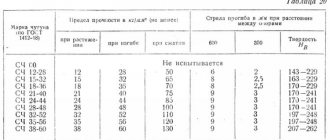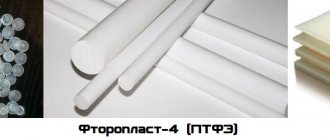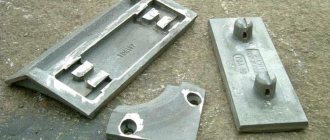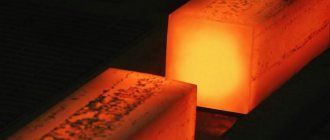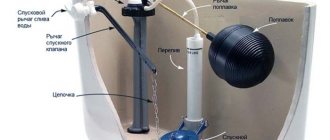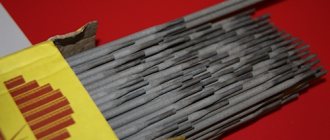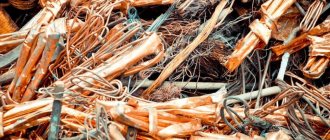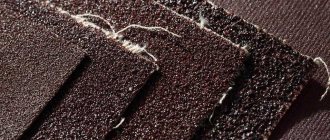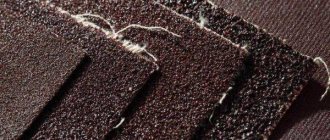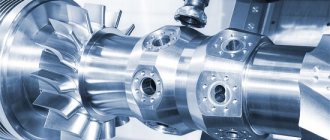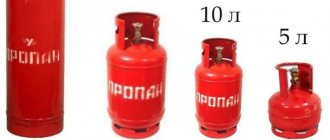The reliability and durability of a product in modern mechanical engineering largely depends on the properties of the structural materials used. Over 80% of mechanical engineering parts of various weights and complexity are made from iron-based alloys. Depending on the carbon content, iron-based alloys are divided into steels and cast irons .
Unlike steel, in cast iron, under certain conditions, part of the carbon is released in the form of graphite rosettes. In the cross-section of such a socket, only individual plates are visible. Therefore, isolated inclusions of graphite are noticeable on a polished section of cast iron. The structure of the matrix is most often ferrite-pearlite or pearlite. This type of cast iron is called gray.
Typically, gray cast iron contains between 2.5% and 3.6% carbon. It contains silicon and manganese in certain quantities. Sulfur and phosphorus are constantly present as impurities.
The strength of cast iron is determined by the presence of plate-shaped graphite in its structure. Such graphite inclusions significantly weaken the matrix. Under the influence of load, stress arises in the metal with the highest concentration at the ends of graphite inclusions. Microcracks appear in these places. Gray cast iron has relatively low strength and breaks without plastic deformation.
Cast iron is a casting alloy.
The cooling conditions of cast iron after filling the mold have a decisive influence on the formation of its structure. In thin sections of the casting, where the cooling rate during the crystallization period is high, a white cast iron . Carbon in it is in the form of cementite, graphite is absent. In the remaining sections, a gray cast iron structure is formed. The chemical composition also affects the structure. As the content of manganese and sulfur increases, the chill zone increases. An increase in the content of graphitizing elements - carbon and silicon - reduces the tendency of cast iron to whiten. To obtain castings with specified properties, it is necessary in each specific case to take into account both the chemical composition and the cooling rate of the cast iron in the mold.
Gray cast iron
Despite its relatively low mechanical properties, gray cast iron is widely used. Because it is easy to process, has increased damping capacity, as well as anti-friction properties. Because the graphite of cast iron holds the lubricant and itself serves as a lubricant. The mating cast iron parts move easily relative to each other.
Gray cast iron with small additions of chromium and nickel acquires good elastic properties. A piston ring made of such cast iron, after removing the load, returns to its original dimensions.
Gray cast iron has high fluidity. At real pouring temperatures, the length of a spiral cast iron sample is almost twice as long as a steel one, which makes it possible to produce castings of complex configurations.
Gray cast iron is characterized by low volumetric shrinkage during crystallization, allowing in many cases to dispense with installation and profit. The most common unit for smelting gray cast iron is a cupola with a dripper, in which metal accumulates, as well as its composition and temperature are averaged. To reduce the tendency of cast iron to chill, it is modified by introducing silicon-containing additives into the liquid metal. Modification allows you to equalize the properties of the metal in different sections of the casting. This can be seen from the example of measuring the hardness of cast iron. Unmodified and modified.
The chill depth on a wedge sample of modified cast iron is significantly less than that of unmodified cast iron. The shape of graphite inclusions also changes as a result of modification.
In addition to cupola furnaces, electric furnaces . They allow metal to be smelted at a higher temperature, which is important for subsequent, out-of-furnace processing of cast iron. Molds for producing castings from gray cast iron are made by compacting the molding sand in flasks. Cores are installed into the mold cavity to perform the internal configuration of the casting.
In mass production, automatic flaskless molding lines , including installation of cores using a core layer.
The metal of the mold is also poured automatically. Gray cast iron castings are made not only in sand molds, but also in metal ones. To produce castings shaped like bodies of rotation, the centrifugal casting method is widely used. At the same time, labor productivity increases, molding materials are not consumed, and there is no gating system.
Gray cast iron is a generally recognized construction material. It is used for the manufacture of various parts operating under conditions of static loads, vibration, and increased friction.
Iron casting
What is cast iron
Cast iron is an alloy of iron and carbon. The percentage of carbon in cast iron is more than 2.14%. This element can be included in cast iron in the form of graphite or cementite.
Varieties
There are white and gray cast iron.
- The carbon in white cast iron is in the form of iron carbide. If you break it, you can see a white tint. White cast iron is not used in its pure form. It is added during the production of malleable iron.
- At a fracture, gray cast iron has a silvery tint. This type of cast iron has a wide range of uses. It lends itself well to processing with cutters.
Cast irons are high-strength, malleable and with special properties.
- High-strength cast iron is used to increase the strength of the product. The mechanical properties of such cast iron allow this to be done perfectly. Ductile iron is obtained from gray cast iron by adding magnesium to the alloy.
- Ductile iron is a type of gray iron. The name does not mean that this cast iron is easily forged. It has increased plasticity properties. It is produced by annealing white cast iron.
- There is also a distinction between half cast iron. Some of the carbon in it is in the form of graphite, and the remaining part is in the form of cementite.
Special Features
The peculiarity of cast iron lies in the process of its production. The average melting point of different types of cast iron is 1200 ºС. This value is 300 degrees less than that of steel. This is due to the very high carbon content. Carbon and iron atoms do not have a very close connection with each other.
During the smelting process, carbon cannot be completely incorporated into the iron crystal lattice; as a result, cast iron is brittle. It cannot be used for the manufacture of parts that will be subject to constant load.
Cast iron is a ferrous metallurgy material. Its characteristics are often compared to steel. Products made of steel or cast iron are widely used in our lives. Their use is justified. After comparing the characteristics, we can say the following about these two materials:
- the cost of cast iron products is lower than the cost of steel ones;
- materials differ in color: cast iron is a dark matte material, and steel is light and shiny;
- cast iron is easier to cast than steel, but steel is easier to weld and forge;
- cast iron is less durable than steel;
- cast iron is lighter in weight than steel;
- Cast iron has a higher carbon content than steel.
Advantages and disadvantages
Cast iron, like any material, has positive and negative properties.
The advantages of cast iron include:
- Carbon in cast iron can be in different states, so this material can be of two types (gray and white).
- Certain types of cast iron have increased strength, so cast iron is sometimes placed on the same line as steel.
- Cast iron can maintain temperature for quite a long time. That is, when heated, the heat is evenly distributed throughout the material and remains in it for a long time.
- In terms of environmental friendliness, cast iron is a clean material. Therefore, it is often used to make dishes in which food is subsequently prepared.
- Cast iron is resistant to acid-base conditions.
- Cast iron has good hygiene.
- The material has a fairly long service life. It has been noticed that the longer cast iron is used, the better its quality.
- Cast iron is a durable material.
- Cast iron is a harmless material. It is not capable of causing even slight harm to the body.
The disadvantages of cast iron include:
- Cast iron will rust if it is exposed to water for a short time.
- Cast iron is an expensive material. However, this minus is justified. Cast iron is very high quality, practical and reliable. Items made from it are also high quality and durable.
- Gray cast iron is characterized by low ductility.
- White cast iron is characterized by brittleness. It is mainly used for smelting.
Properties and characteristics
Cast iron has the following properties:
- Physical. These characteristics include: specific gravity, coefficient of linear expansion, actual shrinkage. Specific gravity varies depending on the carbon content of the material.
- Thermal. The thermal conductivity of a material is usually calculated using the displacement rule. For solid cast iron, the volumetric heat capacity is 1 cal/cm3 oC. If cast iron is liquid, then it is approximately 1.5 cal/cm3*oC.
- Mechanical. These properties depend on the base itself, as well as on the size and shape of the graphite. Gray cast iron with a pearlite base is considered the most durable, and the most ductile is with a ferritic base. The maximum reduction in strength is observed with the “plate” shape of graphite, and the minimum – with the “ball” shape.
- Hydrodynamic. Viscosity in cast iron varies depending on the presence of manganese and sulfur. It also increases sharply when the temperature of cast iron passes the point where solidification begins.
- Technological. Cast iron has excellent casting properties, resistance to wear and vibration.
- Chemical. According to the electrode potential (in decreasing order), the structural components of cast iron are arranged in the following form: cementite - phosphide eutectic - ferrite.
The properties of cast iron are affected by special impurities.
- Thus, the addition of sulfur can significantly reduce fluidity and reduce refractoriness.
- Adding phosphorus at the same time makes it possible to create a product
- The silicon impurity makes the melting point not so high and significantly improves the casting properties. Different percentages of silicon create different types of cast iron, from pure white to ferritic.
- Manganese worsens casting and technological properties, but increases strength and hardness.
Structure and composition
If we consider cast iron as a structural material, then it is a metal cavity with graphite inclusions. The structure of cast iron is mainly pearlite, ledeburite and ductile graphite. Moreover, for each type of cast iron these elements predominate in different proportions or are absent altogether.
According to the structure of cast iron there are:
- pearlite
- ferritic
- ferritic-pearlitic.
Graphite is present in this material in one of the forms:
- Globular. Graphite takes on this shape when magnesium is added. The spherical shape of graphite is characteristic of high-strength cast irons.
- Plastic. Graphite is similar to the shape of petals. In this form, graphite is present in ordinary cast iron. This cast iron has increased ductility properties.
- Flaky. Graphite acquires this shape by annealing white cast iron. Graphite is found in flake form in malleable cast iron.
- Vermicular. The named form of graphite is found in gray cast iron. It was developed specifically to improve ductility and other properties.
Areas of use
Cast iron is common in many areas.
- It is used for the production of parts in mechanical engineering. Engine blocks and crankshafts are mainly made from cast iron. The latter require advanced cast iron, to which special graphite additives are added.
- Cast iron can operate smoothly even at extremely low temperatures. Therefore, it is often used in the production of machine parts that will have to work in harsh climatic conditions.
- Cast iron has proven itself well in the metallurgical field. It is valued for its relatively low price and excellent casting properties. Products made from cast iron are characterized by excellent strength and wear resistance.
- A large variety of plumbing products are made from cast iron. These include sinks, radiators, sinks and various pipes. Cast iron bathtubs and heating radiators are especially famous. Some of them still serve in apartments today, although they were purchased many years ago. Cast iron products retain their original appearance and do not require restoration.
- Thanks to its good casting properties, cast iron produces real works of art. It is often used in the manufacture of artistic products. For example, such as beautiful openwork gates or architectural monuments.
Malleable iron
It is known that such car parts as wheel hubs and differential housings experience dynamic loads. Can cast iron be used to make them? It is possible if its plasticity is significantly increased. Malleable cast iron has this property , in which the graphite has a flake-like rather than a lamellar shape. Compared to gray cast iron, ductile iron has a lower concentration of graphitizing elements - carbon and silicon.
Malleable cast iron is superior to gray cast iron in terms of strength and ductility. Changes in the chemical composition have led to a decrease in fluidity and an increase in shrinkage during solidification, which requires the installation of profits even on small castings. The production of malleable iron usually uses the duplex process.
Cast iron is smelted into a cut, then transported in a transfer ladle and poured into an electric induction furnace, where it is heated before pouring to increase fluidity.
The technological process for producing castings from malleable cast iron is similar to producing castings from gray cast iron. Automatic molding lines are becoming increasingly common. Metal is poured into molds on a conveyor belt. The castings produced must have a white cast iron structure throughout their entire cross-section. To obtain the structure of malleable cast iron, they are subjected to graphitizing annealing in thermal furnaces. During the holding period, white cast iron cementite decomposes and flake-shaped graphite inclusions are formed. After heat treatment, the castings are straightened on special presses.
The need to use long-term heat treatment and straightening significantly increases the complexity of manufacturing parts made of malleable cast iron. The forged steel blank of an engine camshaft is noticeably different from the finished part.
The cast billet is much closer in configuration to it, which greatly reduces the complexity of machining. The same applies to crankshafts, critical parts. To replace forged blanks with cast ones, an alloy is needed that would combine the mechanical properties of steel with the technological and operational properties of cast iron.
Form of graphite in cast iron
?Before the production of cast iron with nodular graphite, the process of forming graphite seemed undoubted. The lamellar form of graphite in gray cast iron was explained by the pronounced anisotropy of the properties of the graphite crystal, its layered structure, and the annealing carbon in malleable cast iron was explained by the diffusion process. The appearance in the 40s of tugun with nodular graphite, high-strength cast iron, and the technological difficulties of its production required a scrupulous study of the sources that determine the formation of nodular graphite, which led to the creation of countless hypotheses and theories of the formation of nodular graphite. In modern times, many researchers have turned away from their old beliefs and changed their own views. This was facilitated by the accumulation of experimental material obtained with the support of better laboratory equipment, as well as a rethinking of previously learned results.
HF has a chemical that cannot be canceled out by the composition of gray cast iron with a higher carbohydrate content, but contains less sulfur and phosphorus. The lamellar form of graphite in cast iron is explained by the fact that unhealthy impurities, especially sulfur and oxygen, have a detrimental effect on the growth of graphite in liquid cast iron . Typically, graphite as it grows takes on a spherical shape, but the action of impurities suppresses the growth of graphite crystals in established planes, and they are forced to grow in the form of plates. When producing HF, not only is a thick impurity content maintained, but also to the liquid iron . These elements bind sulfur and oxygen in liquid cast iron and prevent their detrimental effect on the growth of graphite. In the effect, graphite is formed, acquiring a spherical structure.
The dislocation theory was called upon to explain the sources of growth of spheroidal graphite already in the early stages of producing high-strength cast iron. According to this hypothesis, the role of modification and unchanged elements is to clean the basal faces of the crystal from sulfur, oxygen and other surface-energetic elements that slow down the growth of spiral protrusions. This approach to explaining the spherical shape bases the modification processes on the refining of the alloy from introductory-energetic elements and proceeds from the fact that in pure iron-silicon-carbon alloys, graphite should crystallize into a spherical shape. Adherents of these concepts do not constantly explain the significance of other phenomena (processes) in the formation of graphite (why the prismatic face of graphite behaves this way and why a polycrystal in the form of a spherulite is formed, and not a cylindrical single crystal).
Carbon in cast iron can be in the form of cementite, graphite, or at the same time in the form of cementite and graphite. The appearance of a permanent phase - graphite in cast iron can occur as a result of its direct separation from a weak (solid) solution or as a result of the decomposition of pre-formed cementite (with slow cooling of molten cast iron, cementite can undergo decomposition ResC -> Fe + GC with the formation of ferrite and graphite). The process of forming in cast iron (steel) is called graphization.
Cast iron is an alloy of iron and carbon with a content of more than 2.14% (the point of limiting solubility of carbon in austenite on the state diagram). Carbon in cast iron can be contained in the form of cementite and graphite. Depending on the form of graphite and the amount of cementite, there are: pale, colorless, malleable and high-strength cast irons. Cast irons contain permanent impurities (Si, Mn, S, P), and in some cases also alloying elements (Cr, Ni, V, Al, etc.). Typically, cast iron is brittle.
An alloy of iron and carbon (> 2.14% C) is called cast iron. The presence of eutectic in the structure of cast iron determines its use exclusively as a casting alloy. Carbon in cast iron can be in the form of cementite or graphite, or at the same time in the form of cementite and graphite. Cementite gives the fracture a specific light gloss. Therefore, cast iron, in which all the carbon is in the form of cementite, is called pale. Graphite gives cast iron a gray tone, which is why cast iron is called colorless. Depending on the form of graphite and the circumstances of its formation, the following cast irons are distinguished: colorless, high-strength and malleable.
Cast iron is an alloy of iron and carbon with a content of more than 2.14% (the point of limiting solubility of carbon in austenite on the state diagram). Carbon in cast iron can be contained in the form of cementite and graphite. Depending on the form of graphite and the amount of cementite, there are: pale, colorless, malleable and high-strength cast irons. Cast irons contain permanent impurities (Si, Mn, S, P), and in some cases also alloying elements (Cr, Ni, V, Al, etc.). Typically, cast iron is brittle.
The analysis of theories (assumptions) of the formation of spherical graphite allows us to conclude that the new assumptions considered, taking into account the refining into the interphase state of lines, most fully answer questions of both theoretical and applied nature. These hypotheses can be the basis for subsequent scientific exploration and development of the latest technologies for producing spheroidal graphite cast iron .
Related posts:
- Graphite in cast iron
- Graphite cast iron
- Cast iron with flake graphite
- Carbon content of cast iron
- Impurities in cast iron
The meaning of the phrase school supplies chudesenka.ru. Built-in refrigerators midea Rostov techd.ru.
